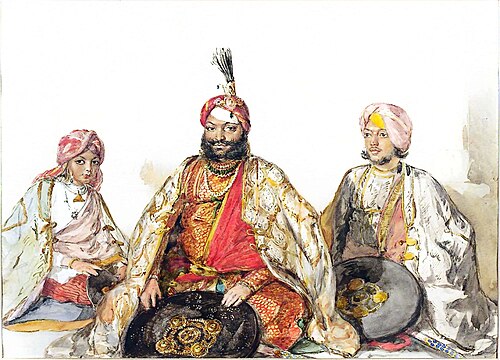IMAM UDDIN, SHAIKH (1819-1859), who succeeded his father, Shaikh Ghulam Mohly udDin, as governor of the Sikh province of Kashmir in 1845, had earlier served under Kanvar Nau Nihal Singh in the Derajat and had in 1840 assisted his father in the campaign against Mandi. In April 1841, when a mutiny occurred in Kashmir, Maharaja Sher Singh ordered his father, Sheikh Ghulam Mohiy udDin, then governor of the Jalandhar Doab, to proceed to Kashmir to take charge of the province and restore order. Shaikh Imam udDin was then appointed governor of the Jalandhar Doab. When in September 1843, Wazir Hira Singh had Bhai Gurmukh Singh and Misr Belt Ram arrested, he handed them over to Shaikh Imam udDin for custody.
Imam udDin kept them in the stables near his house in Lahore.Within a week of their confinement, both of them were put to death at Hira Singh`s orders. Shaikh Imam udDin was also involved by Hira Singh in the plot to destroy the dera of Baba Bir Singh of Naurangabad which fell within his jurisdiction. During the insurrection in Kashmir in 1844 when Shaikh Ghulam Mohiy udDin asked for reinforcements from the Lahore Darbar, Shaikh Imam udDin was sent with a contingent to help him. On the death of his father, Imam udDin took over as governor of Kashmir, with the title of Amin ulMulk Jang Bahadur.
His fortune, however, declined with the conclusion of the Anglo Sikh treaty of 16 March 1846, according to which Kashmir was to be handed over to Gulab Singh. The arrangement was resented by Raja Lal Singh, minister to the Lahore Darbar, who in a private communication instructed Shaikh Imam udDin to obstruct it. Shaikh Imam udDin was ultimately overcome by the intervention of the British under Major Henry Lawrence to whom he surrendered.He was tried at Lahore by a commission comprising Major General Littler, Lt Colonel Lawrence, Lt Colonel Goldie, Mr Currie and Mr Lawrence, but was exonerated when he produced original letters written by Raja Lal Singh.
His property in Lahore, which was earlier confiscated, was restored to him. In June 1848, Shaikh Imam udDin went at the head of 2,000 troops to assist Herbert Edwardes in the reduction of Multan, and succeeded in arresting Narain Singh, commander of Diwan Mul Raj. He was later rewarded with the title of Nawab and Bahadur, together with a pension of Rs 11,600 and confirmation of his jdglr of Rs 8,400. Again in 1857, he helped the British raise two contingents of cavalry to fight on their behalf in Delhi. He died in March 1859 at the early age of 40 and was buried in the vicinity of the tomb of the famous saint. Data Ganj Bakhsh, at Lahore.
References :
1. Suri, Sohan Lal, `Umdal ut-Twdnkh. Lahore, 1885-89
2. Griffin, Lcpel, and C.F. Massy, Chiefs and Families of Note in the Punjab. Lahore, 1909
3. Harbans Singh, The Heritage of the Sikhs. Delhi, 1983
4. Fauja Singh, After Ranjit Singh. Delhi, 1982
Shaikh Imam-ud-Din (1819–1859) stands out as a complex and controversial figure during one of Kashmir’s most turbulent historical periods. Born into a family with strong political roots—his father, Shaikh Ghulam Muhy-ud-Din, being a respected governor who had worked to reverse discriminatory policies imposed on Kashmir after its conquest—Imam-ud-Din inherited not only a title but also a heavy legacy when he succeeded his father in Kashmir during 1845.
His brief tenure as the governor of Kashmir (from March 25 to October 25, 1846) was marked by fierce political upheaval. In the wake of the First Anglo-Sikh War, the Treaty of Amritsar (signed in 1846) mandated that control of the Kashmir Valley be transferred to Gulab Singh, a leading Dogra noble. However, influenced by court intrigues—most notably by Raja Lal Singh, a minister in the Lahore Darbar—Imam-ud-Din refused to yield his authority over the region. His defiance was not merely a refusal of political change; it was a fundamentally contested stand against the external imposition of a new regime. The ensuing tensions culminated in British intervention under Major Henry Lawrence, and on November 1, 1846, Imam-ud-Din surrendered, thereby altering the fate of the Kashmir Valley and paving the way for Dogra rule.
After his surrender, the British authorities subjected him to a commission in Lahore. Remarkably, he managed to exonerate himself by presenting original letters from Raja Lal Singh that justified his actions. Later, his cooperation was recognized when he led troops in military operations—most notably assisting Herbert Edwardes in the reduction of Multan—and he was rewarded with titles, pensions, and the confirmation of his jagir. Nonetheless, the controversy of his earlier resistance lingers in historical debates. On one hand, some view Imam-ud-Din as a defender of local Muslim and Kashmiri interests, standing up against swiftly changing power structures; on the other, his opposition is seen as a reactionary measure that ultimately contributed to Kashmir’s fractious political realignment.



